| Pages:
1
2
3
4
5
..
7 |
Zyklon-A
International Hazard
    
Posts: 1547
Registered: 26-11-2013
Member Is Offline
Mood: Fluorine radical
|
|
Yes, I hate them to, but I have to admit, as far as I remember that is what got me interested in chemistry, I saw something there, tried it, and
miracle of miracles, it worked, almost nothing else there works though.
|
|
|
Pard
Harmless

Posts: 38
Registered: 29-11-2013
Member Is Offline
Mood: No Mood
|
|
Quote: Originally posted by Zyklonb  | Here, I found something that says you can make a 'cheddite' with KNO3, I don't trust this site at all, but I tried it anyway, it says ''When wet
it is harmless... but when it dries it is
highly explosive and shock sensitive. ****store in oil''.
''Well this is stupid'', I thought, petroleum jelly never will dry, anyway, it didn't work at all, I followed the instructions exactly, and just for
fun I set it out to 'dry', now 2 months later it looks the same, not going to work at all, ever.
I suggest that you don't try anything from this site, about half of the things they say are false, and the other half can get you killed.
[Edited on 30-12-2013 by Zyklonb] |
Wow wee, this must be writ by comedians. Listen to this one tells you to tape nails to a can of vaseline and then stick a fuse in and it will blow up?
What nonsense.
Currently I have some NH4ClO4 and will obtain some vaseline soon in order to try the cheddite as proposed with it. I cannot recall which thread it was
exactly, perhaps this one.
|
|
|
Zyklon-A
International Hazard
    
Posts: 1547
Registered: 26-11-2013
Member Is Offline
Mood: Fluorine radical
|
|
It seems like they think a 1 to1 raito will work all the time, or some times, nothing at all."Just mix I2 with NH3 (aq), and you'll get some black
stuff, just filter it off and then leave it to dry in you're room (or some other very safe place like your closit or behind the toilite").
|
|
|
markx
National Hazard
   
Posts: 645
Registered: 7-8-2003
Location: Northern kingdom
Member Is Offline
Mood: Very Jolly
|
|
Quite the energetics these chloratites....made a small test on the simplest formulation with 9 kclo3/1 kerosene (30g):
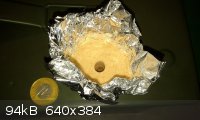 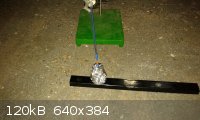 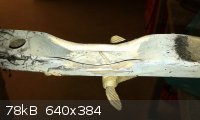 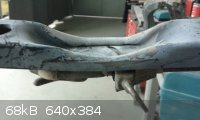
The yellowish coloration is due to iron oxides from the milling media, but nonetheless it left a nice mark on the witness body
Exact science is a figment of imagination.......
|
|
|
Hennig Brand
International Hazard
    
Posts: 1284
Registered: 7-6-2009
Member Is Offline
Mood: No Mood
|
|
If you used a ball mill, you would have easily been able to get the chlorate down to smaller particle size than I did, which should improved
sensitivity and propagation. What I produced with the homemade sieve was about 100 mesh, but a ball mill could do much better. What did you use for an
initiator?
Is the piece of material (witness plate) in the second picture supposed to be the same as the piece of material in the third and fourth? Not really
sure what the charge is supposed to have done to the target exactly. What is the target?
[Edited on 1-1-2014 by Hennig Brand]
"A risk-free world is a very dull world, one from which we are apt to learn little of consequence." -Geerat Vermeij
|
|
|
roXefeller
Hazard to Others
  
Posts: 463
Registered: 9-9-2013
Location: 13 Colonies
Member Is Offline
Mood: 220 221 whatever it takes
|
|
It looks like a C-channel steel, or a rectangular extrusion. With a difference in lighting conditions, they seem to be the same, same hole placement
and black splatter on the left.
[Edited on 1-1-2014 by roXefeller]
|
|
|
markx
National Hazard
   
Posts: 645
Registered: 7-8-2003
Location: Northern kingdom
Member Is Offline
Mood: Very Jolly
|
|
Test body is rectangular steel tube with 1,6mm wall thickness. There was no pinpoint objective on what the charge should have done to the test body in
that experiment...I guess what you see in the last pictures is about exactly that what could have been expected  (And yes, the pictures are of the same test piece) (And yes, the pictures are of the same test piece)
ETN/SADS (600/60mg) compund cap was used for stirring things up. Like this one:
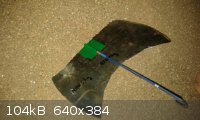 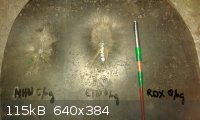
[Edited on 1-1-2014 by markx]
Exact science is a figment of imagination.......
|
|
|
Dany
Hazard to Others
  
Posts: 482
Registered: 3-8-2013
Member Is Offline
Mood: No Mood
|
|
Quote: Originally posted by markx  | Test body is rectangular steel tube with 1,6mm wall thickness. There was no pinpoint objective on what the charge should have done to the test body in
that experiment...I guess what you see in the last pictures is about exactly that what could have been expected  (And yes, the pictures are of the same test piece) (And yes, the pictures are of the same test piece)
ETN/SADS (600/60mg) compund cap was used for stirring things up. Like this one:
[Edited on 1-1-2014 by markx] |
What about the loading density of each of each explosive tested? this is important so you can compare between the 3 explosives. having the same mass
(0.6 g) is not enough for comparison if you don't know the loading density. Have you tried to check up the loading density?
Dany.
|
|
|
markx
National Hazard
   
Posts: 645
Registered: 7-8-2003
Location: Northern kingdom
Member Is Offline
Mood: Very Jolly
|
|
Yes, I'm well aware of the importance of loading density and no, I have not tried to measure or match it so far. But when referring to the series in
my last post, I owe an explanation: the three compounds were used not to compare their effect, but to test the primary's ability to initiate them  Therefore I did not spend any effort on exacty matching their density, they were just
lightly compacted to fit the casing snugly and uniformly. Therefore I did not spend any effort on exacty matching their density, they were just
lightly compacted to fit the casing snugly and uniformly.
Exact science is a figment of imagination.......
|
|
|
Dany
Hazard to Others
  
Posts: 482
Registered: 3-8-2013
Member Is Offline
Mood: No Mood
|
|
Quote: Originally posted by markx  | | I did not spend any effort on exacty matching their density, they were just lightly compacted to fit the casing snugly and uniformly.
|
As you know the initiating ability of a substance depend also on the density of the main charge. with increasing density charge the initiation become
harder (because of the lack of enough voids and inhomogeneities for hot spot formation). Some explosive become dead pressed when confined to high
density (which is not a problem in your case). So density should be checked as far as possible so as to get good results with logical conclusions
Dany.
|
|
|
roXefeller
Hazard to Others
  
Posts: 463
Registered: 9-9-2013
Location: 13 Colonies
Member Is Offline
Mood: 220 221 whatever it takes
|
|
By matching do you mean identical densities? Is having identical densities necessary? I suppose that propagating waves would have less reflection
and more transmission at the boundary if there wasn't a density discontinuity, but this seems like a minor effect.
|
|
|
markx
National Hazard
   
Posts: 645
Registered: 7-8-2003
Location: Northern kingdom
Member Is Offline
Mood: Very Jolly
|
|
All true...the tighter it sits, the harder it is to wake up (thanks for pointing that out), but I worked towards a specific case this time : these 3
compounds, "hand compressed" with same mass of primary/secondary through the series. The question: go or no go?
Got my answer  : :
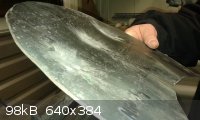
No further conclusions were drawn from the results this time.
Of course having identical densities is not neccesary, but it may make comparison easier (depending of course on what the initial goal of the
experiment is)
[Edited on 1-1-2014 by markx]
Exact science is a figment of imagination.......
|
|
|
Hennig Brand
International Hazard
    
Posts: 1284
Registered: 7-6-2009
Member Is Offline
Mood: No Mood
|
|
The following table, showing more modern French Cheddite formulations, is from "Military Explosives TM 9-1300-214" (1984). Average density for these
charges was stated as being 1.3 g/mL. Notice that there is more DNT and less chlorate used than in the older formulations previously posted. Notice
also that no castor oil is used.

"A risk-free world is a very dull world, one from which we are apt to learn little of consequence." -Geerat Vermeij
|
|
|
Hennig Brand
International Hazard
    
Posts: 1284
Registered: 7-6-2009
Member Is Offline
Mood: No Mood
|
|
The following is a copy/paste from an archived copy of some of the rec.pyrotechnics newsgroup posts. These guys know a lot about the subject matter,
and I thought it would be good to post this very concise and informative description of how these types of explosives behave.
Newsgroups: rec.pyrotechnics
From: arno@utu.fi (Arno Hahma)
Subject: Re: Na/KClO3 w/ Vaseline??
Organization: University of Turku
Date: Wed, 5 Jul 1995 10:16:03 GMT
In article <3tavr6$rh1@geraldo.cc.utexas.edu>,
Gerald L. Hurst <glhurst@onr.com> wrote:
>not both. My question relates to whether the
>material truly supports a classic detonation head
>or if, instead, it reacts only at the deflagrating
>surface like a propellant, only much faster than
Yes and no. The (per)chlorate/vaseline mixture detonates at about 3000 m/s
at a density of 1.3 g/ccm and about 4000 m/s at a density of 1.5. [J.
Wuorinen, "Räjähdysaineoppi", Otava (1928), Helsinki, Finland, pp.
162-165, in Finnish; T. Urbanski, "Chemistry and Technology of
Explosives", Pergamon Press (1986 reprint), Exeter, Great Britain,
Vol. 3, pp. 277-279].
If you calculate the theoretical detonation velocity assuming 100 %
reactivity, you'll get something like 5000..6000 m/s. With the mere
3000 m/s there is still a detonation, but only about 30 % of the
material is reacting based on calculations. Thus, the detonation is
highly unideal (i.e. not a classic one) and sensitive to the particle
size of the chlorate (more surface, more contact to the fuel, more fuel
reacting, higher detonation velocity) and to the way the material is
packed and initiated. Also, the nature of the fuel is going to make a
big change - use something like nitrobenzene or dinitrobenzene and
you'll get a considerably higher velocity because shocking the fuel is
not eating so much energy as shocking vaseline.
Potassium chlorate is pretty "neutral" towards shock, it releases some
energy when decomposed, but not enough to sustain detonation. As a
result, you only need to add a little energy to get the detonation
going. But, you need a continous phase of some kind to transmit the
shockwave through the mass without too much attenuation. This
is one of the reasons, why powdered mixtures (like perchlorate/Al or
chlorate/sugar) are so hard to detonate.
KClO4/Al at least does not detonate at all (not even deflagrates
reliably, unless the Al is extremely fine powder), which doesn't mean
it wouldn't be hazardous or wouldn't explode. I have an article
in print about this in Propellants, Explosives, Pyrotechnics and I'm
also going to present information about it in the next ADPA conference
in September.
>Many people might say "who cares," but it is of
>very great interest to me and probably others
>in this forum.
Yep! The same applies to ANFO as well. ANFO also detonates
very unideally with only about 50 % of the material contributing
to the shock energy unless extremely well confined. Again, the amount
of material reacting at the reaction zone (as far as classical
detonation is concerned) is highly dependent on variables like charge
diameter, confinement, particle size, degree of mixing, fuel
composition etc. Good references are C. Mader, "Numerical Modeling of
Detonations", UCLA Press, Berkeley and LA (1984), p. 99 and A. C. van
der Steen et al., "Detonation Velocities of the Non-Ideal Explosive
Ammonium Nitrate" in Propellants, Explosives, Pyrotechnics 15 pp. 58-61
(1990).
"A risk-free world is a very dull world, one from which we are apt to learn little of consequence." -Geerat Vermeij
|
|
|
testimento
Hazard to Others
  
Posts: 351
Registered: 10-6-2013
Member Is Offline
Mood: No Mood
|
|
So, packing up 90 parts of powdered chlorate and 10 parts of fuel oil with a good detonator will do the job?
|
|
|
markx
National Hazard
   
Posts: 645
Registered: 7-8-2003
Location: Northern kingdom
Member Is Offline
Mood: Very Jolly
|
|
That is ratio by mass, as always (just to avoid confusion). And yes, it packs quite a punch....is loud as hell too.
Exact science is a figment of imagination.......
|
|
|
testimento
Hazard to Others
  
Posts: 351
Registered: 10-6-2013
Member Is Offline
Mood: No Mood
|
|
Excellent. Gotta wake up my 3kW electrolysis cell. 
Could this composition be initiated with ball mill powdered ammonium perchlorate aluminium mixture, maybe 10-50g charge?
|
|
|
markx
National Hazard
   
Posts: 645
Registered: 7-8-2003
Location: Northern kingdom
Member Is Offline
Mood: Very Jolly
|
|
I do not know if flash will wake it up....I would not count on it though. I'd rather try a smaller sharper slap to get it going (nitric esters,
nitramines etc.). Besides if only your booster is already going to weigh 50g, man, better not to work with such quantities. Keep it safe, friend!
Exact science is a figment of imagination.......
|
|
|
Hennig Brand
International Hazard
    
Posts: 1284
Registered: 7-6-2009
Member Is Offline
Mood: No Mood
|
|
Quote: Originally posted by markx  |
That is ratio by mass, as always (just to avoid confusion). And yes, it packs quite a punch....is loud as hell too. |
Potassium chlorate and fuels, liquid and/or solid, can be made to detonate, but they are not Cheddites AFAIK. I have seen a couple of different
definitions, that differ slightly, but I think a Cheddite always has nitroaromatic(s) in it.
"A risk-free world is a very dull world, one from which we are apt to learn little of consequence." -Geerat Vermeij
|
|
|
markx
National Hazard
   
Posts: 645
Registered: 7-8-2003
Location: Northern kingdom
Member Is Offline
Mood: Very Jolly
|
|
Urbanski also states mixtures without nitroaromatics as members of the cheddite family:
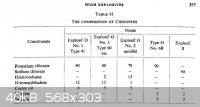
So I guess the definitions are a bit vague...
Exact science is a figment of imagination.......
|
|
|
Hennig Brand
International Hazard
    
Posts: 1284
Registered: 7-6-2009
Member Is Offline
Mood: No Mood
|
|
The common link in that table seems to be the moderant (castor oil or petroleum wax). Ok, potassium or sodium chlorate with wax or Vaseline are often
classified as Cheddites, but I don't think Chlorate with liquid hydrocarbons alone are (I could be wrong). Anyway, interesting that it works
especially since it is a very simple explosive with easily obtained/made components.
"A risk-free world is a very dull world, one from which we are apt to learn little of consequence." -Geerat Vermeij
|
|
|
Zyklon-A
International Hazard
    
Posts: 1547
Registered: 26-11-2013
Member Is Offline
Mood: Fluorine radical
|
|
How well do cheddites work with no kerosene (only petroleum jelly), are they more difficult to detonate. I don't have any kerosene an the moment.
|
|
|
testimento
Hazard to Others
  
Posts: 351
Registered: 10-6-2013
Member Is Offline
Mood: No Mood
|
|
Do you have any idea what would be the RE Factor and detonation velocity of ball milled Na/KClO3+FO 90:10 mixture initiated with good booster like
ETN?
And btw, why everyone outright prefer potassium chlorate instead of sodium? The latter has more oxygen in weight(6%), it comes straight out of
chlorate cell and it's only drawback is that it absorbs water - but hey, everyone still uses AN with FO and everyone's fine with that? I suppose that
NaClO3 can be dried ground dry when heated up to 150-200C.
[Edited on 6-1-2014 by testimento]
|
|
|
Gargamel
Hazard to Others
  
Posts: 166
Registered: 9-3-2013
Member Is Offline
Mood: No Mood
|
|
Thank you for posting your experiences and blast reports.
I'm very interested in this kind of mixtures because my chlorate cell provides me with an endless supply of raw material.
The old commercial mixtures with nitroaromatics in them aren't much of value for the hobbyist, especially with nitrates and acids becoming more
regulated for us in the EU.
I'd prefer to produce something like ETN over wasting precious nitric ect. for DNT, only to get stuff that is barely faster than 3000m/s and has
obviously trouble to fully detonate without confinement.
| Quote: |
And btw, why everyone outright prefer potassium chlorate instead of sodium? The latter has more oxygen in weight(6%) |
I wonder if one can actually use this oxygen with oil. Most Chlorate mixtures do not seem to detonate very well with more than 9% oil. Therfore I
wonder if the common ratios have necessarely something to do with OB?
[Edited on 6-1-2014 by Gargamel]
|
|
|
Turner
Hazard to Others
  
Posts: 197
Registered: 2-12-2013
Member Is Offline
Mood: No Mood
|
|
TNT can be very nitric acid efficient depending on the operator and reaction circumstances.
RDX is by far the worst and most frustrating explosive if you value the costly nitric acid, 50ml gave me 6 grams of RDX and that isn't far off from
theoretical yield.
|
|
|
| Pages:
1
2
3
4
5
..
7 |